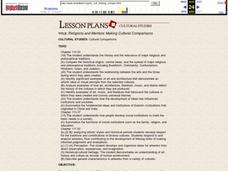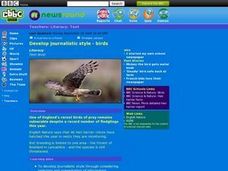Curated OER
"Sum, Sum, Sum It Up!"
Students are provided with a model of how to better comprehend text through using a summarization rubric which includes: deleting trivial information, deleting repeated information, substituting easy words for lists of items, adding a...
Curated OER
Fables
In this fables worksheet, students learn about the different parts of a fable. They learn how to retell a story, analyze the characters, identify the moral and dramatize the story.
Curated OER
A Day in the Life of Amenemhet and Hemet
Students, after watchin the story What Does This Show, summarize everyday life in ancient Egypt by writing about a typical day in the life of an Egyptian man or woman
Curated OER
Religions and Mentors: Making Cultural Comparisons
High schoolers compare the Tirthankara of Jain religious stories and compare it to mentors who appear throughout Western stories. Studentsl create a narrative or a portrait in honor of a mentor of his or her own.
Curated OER
Empowering Young People to Repair the World
Students analyze the role of study vs. good deeds in contributing to improving the world. They discuss how study and action are important and consider their obligation to make the world a better place. After discussing the concept of...
Curated OER
Map It Out!
Students open their Alabama history book to the chapter on the Civil Rights Movement noticing how the chapter is broken into headings. They read a passage and as a class, create a story map focusing on the main ideas and details.
Curated OER
Bridge to Terabithia
Students read Katherine Paterson's book, A Bridge to Terabithia, and select small groups to complete a project based on a chapter of the book. They create a story web for the chapter, summarize it, design a brochure or advertisement,...
Curated OER
Place as a Mirror of Self and community
Eighth graders study difference and community by exploring a special place in their lives. In this Geography lesson, 8th graders discover a geographic place of importance to them and their family. Students summarize what many...
Curated OER
Who's Boss in a Fairy Tale?
Students analyze the story of Cinderella to determine who is the authority and how justice works in the context of the story as well as determining which elements of the story could happen and which are fanciful.
Curated OER
Comparing and Analyzing Literary Works
Students read two short stories by the same author. For each story, they identify the main structures and style of the author. They use the text to write a summary about each story and how the author used literary techniques.
Curated OER
Integrated Social Studies and Storytelling Lesson
Fourth graders study the Civil War. They examine online photos that are connected to Indiana's role in the Civil War. They choose one of these photos and in a story circle, tell a story about it. They tell who is in the picture, what...
Curated OER
Develop Journalistic Style--Birds
Students develop journalistic style of writing through considering selection and presentation of information. Students tie science with journalistic writing. Students summarize several science species.
Curated OER
Bible: Lesson 1
Students identify times in the Bible when God provided for the Israelites. In this God's provision lesson, students read Joshua 7-8:29 to discover the ways God provided for the Israelites in their battles with Ai. Students then...
Curated OER
Encounter with a Skull (Tae dokuro, 1890)
Students read and analyze a short story by Koda Rohan. They conduct research, read and discuss a biography of the author, identify examples of Japanese and Buddhist symbolism in the story, and write an original story.
Curated OER
The Environment In The News
Students explore environmental issues. Using a newspaper, students scan headlines for articles related to environmental or sustainability issues. From the article title, students predict the article's intent and then read the article for...
Curated OER
Growing a Winter Garden
Second graders listen to a planting story as read by their teacher. Using the text, they summarize the events and complete a KWL chart. They point to the vegetable after it was planted in the garden in the story. They practice using new...
Curated OER
Ending At Owl Creek
Young scholars engage in a reading of "An Occurrence At Owl Creek" in order to work on the reading comprehension skills of prediction with looking at the ending. They predict the next events leading to the ending and summarize how it...
Curated OER
The Secret School( Chapters 2 & 3)
Fourth graders read with a partner to practice reading. In this reading instructional activity, 4th graders will analyze the characters in the chapters of the book the Secret School. Students work on a list of important characters,...
Curated OER
Carbons to Computers - 3
Students develop interviewing techniques--organize ideas and materials; record and summarize data; develop hypotheses about information collected; present results.
Curated OER
Charlotte's Web Animal Research Projects
Students summarize information taken from the internet about animal character's from the story, "Charlotte's Web." Questions are created, answered, and entered into a book about the animal of their choice.
Curated OER
Technology Integration Lesson Plan
Eighth graders research a novel and provide a summary of the story. They relate this information to their lives and evaluate the positives and negatives of the American Revolution. Groups create a PowerPoint presentation on their findings.
Curated OER
1...2...3... You've got a Summary
Students participate in a reading literacy lesson that focuses on the skill of summarization that aids in comprehension. The goal of reading is comprehension which makes this type of lesson important.
Curated OER
Accidental Discoveries
Young scholars view and discuss several video segments and then work in groups to identify several scientific discoveries that were made by accident. They summarize their findings and present them to the class.
Curated OER
Myths and Folk Tales
Seventh graders perform research in order to appreciate stories taken from the genre of myths and fables. The examples of the stories create a context for students to create their own myths.

























